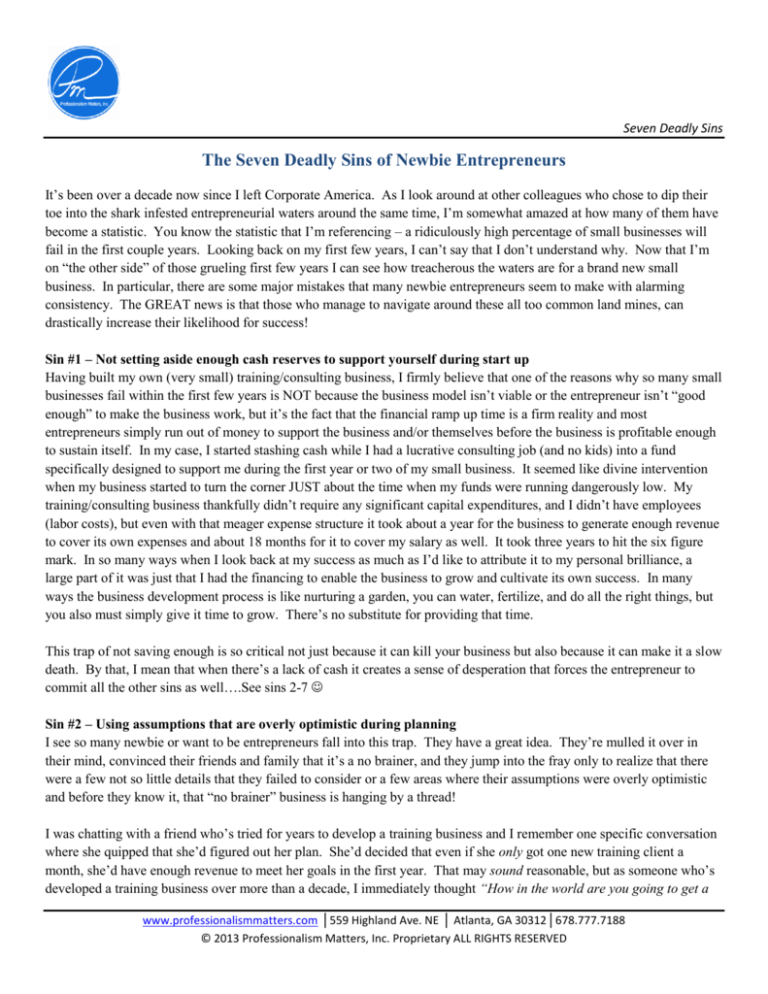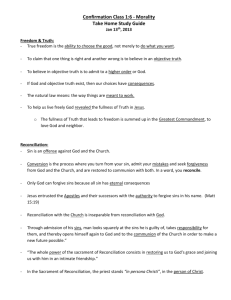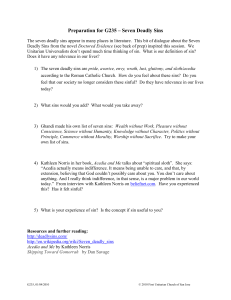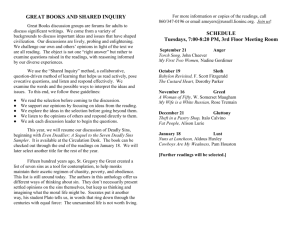
Seven Deadly Sins
The Seven Deadly Sins of Newbie Entrepreneurs
It’s been over a decade now since I left Corporate America. As I look around at other colleagues who chose to dip their
toe into the shark infested entrepreneurial waters around the same time, I’m somewhat amazed at how many of them have
become a statistic. You know the statistic that I’m referencing – a ridiculously high percentage of small businesses will
fail in the first couple years. Looking back on my first few years, I can’t say that I don’t understand why. Now that I’m
on “the other side” of those grueling first few years I can see how treacherous the waters are for a brand new small
business. In particular, there are some major mistakes that many newbie entrepreneurs seem to make with alarming
consistency. The GREAT news is that those who manage to navigate around these all too common land mines, can
drastically increase their likelihood for success!
Sin #1 – Not setting aside enough cash reserves to support yourself during start up
Having built my own (very small) training/consulting business, I firmly believe that one of the reasons why so many small
businesses fail within the first few years is NOT because the business model isn’t viable or the entrepreneur isn’t “good
enough” to make the business work, but it’s the fact that the financial ramp up time is a firm reality and most
entrepreneurs simply run out of money to support the business and/or themselves before the business is profitable enough
to sustain itself. In my case, I started stashing cash while I had a lucrative consulting job (and no kids) into a fund
specifically designed to support me during the first year or two of my small business. It seemed like divine intervention
when my business started to turn the corner JUST about the time when my funds were running dangerously low. My
training/consulting business thankfully didn’t require any significant capital expenditures, and I didn’t have employees
(labor costs), but even with that meager expense structure it took about a year for the business to generate enough revenue
to cover its own expenses and about 18 months for it to cover my salary as well. It took three years to hit the six figure
mark. In so many ways when I look back at my success as much as I’d like to attribute it to my personal brilliance, a
large part of it was just that I had the financing to enable the business to grow and cultivate its own success. In many
ways the business development process is like nurturing a garden, you can water, fertilize, and do all the right things, but
you also must simply give it time to grow. There’s no substitute for providing that time.
This trap of not saving enough is so critical not just because it can kill your business but also because it can make it a slow
death. By that, I mean that when there’s a lack of cash it creates a sense of desperation that forces the entrepreneur to
commit all the other sins as well….See sins 2-7
Sin #2 – Using assumptions that are overly optimistic during planning
I see so many newbie or want to be entrepreneurs fall into this trap. They have a great idea. They’re mulled it over in
their mind, convinced their friends and family that it’s a no brainer, and they jump into the fray only to realize that there
were a few not so little details that they failed to consider or a few areas where their assumptions were overly optimistic
and before they know it, that “no brainer” business is hanging by a thread!
I was chatting with a friend who’s tried for years to develop a training business and I remember one specific conversation
where she quipped that she’d figured out her plan. She’d decided that even if she only got one new training client a
month, she’d have enough revenue to meet her goals in the first year. That may sound reasonable, but as someone who’s
developed a training business over more than a decade, I immediately thought “How in the world are you going to get a
www.professionalismmatters.com │559 Highland Ave. NE │ Atlanta, GA 30312│678.777.7188
© 2013 Professionalism Matters, Inc. Proprietary ALL RIGHTS RESERVED
Seven Deadly Sins
new paying client every month?” My business is one where I’ve have a small number of main clients providing repeat
business over several years, but it took lots and lots of lunches, client meetings, free webinars, lunch and learn sessions,
etc. to develop each and every relationship. Again, I can only speak from my experience/industry, but her assumption of
getting one new paying client each month (twelve/year) with virtually zero reference clients, minimal website presence,
and minimal professional training experience was completely ludicrous in my mind. Later, she came to see that that
assumption was completely unrealistic and ultimately took a part time contract position while she tries to get her business
off the ground.
Talking to other wanna be/newbie small business owners, I’ve heard similar unrealistic planning assumptions that proved
very harmful if not fatal to the business:
- Overestimating demand for the product/service
- Underestimating time required to get the first client
- Underestimating time required to do marketing, business development, website development, social media
outreach, and other critical non revenue generating activities
- Assuming that it will be easy to win clients from existing business relationships
- Assuming zero risk – not allowing for what will go wrong
- Assuming that it will be fairly easy to find the right people to support the business (employees, vendors, or other
stakeholders)
In my case, I made some of these same unrealistic assumptions. Here are just a few… I didn’t plan on having to sue a
client for non payment in the first couple years. I was completely shocked at just how difficult it was to win clients
(particularly the first few) – for some crazy reason I thought that clients would flock to me just because I was a great
trainer (not true ). I continue to struggle with the balance of working “on the business” while also working “in the
business” – it’s difficult to predict/manage the time allocation split between business marketing and execution activities.
(If someone has the right formula, please let me know!) When I first left management consulting, a colleague told me that
they wanted to bring me in to do about $50K in training immediately – never materialized. Thanks goodness I had my
nest egg (see Sin #1).
Sin #3 – Not properly evaluating your business model
I guess this is where my MBA and Engineering degrees come in handy. I love models and my mind inherently thinks
fairly strategically so for me, it felt fairly natural to analyze my business model. But not everyone incorporates this into
their planning. It’s so easy to get really lathered up around the concept of your business, but it’s quite another thing to put
pen to paper (or I’m sure there’s an app these days) to help you objectively evaluate your overall business model and its
profit potential. The simple truth is that having a great idea is just a start – it doesn’t necessarily translate into a profitable
business model (think online grocery shopping which was thought to be the next big thing towards the end of the last
Millenium).
Let’s get real – what in the heck does business model really mean???? My non SBA expert view is that it’s a
representation of the structure of your business and how it will serve customers and generate profit. Considerations could
include the following:
- Product or service based business
- Business to Business or Business to Consumer sales model
www.professionalismmatters.com │559 Highland Ave. NE │ Atlanta, GA 30312│678.777.7188
© 2013 Professionalism Matters, Inc. Proprietary ALL RIGHTS RESERVED
Seven Deadly Sins
-
Sales online, through distributors, directly, etc?
Franchise based?
Years ago one of my friends started a “life coaching” business. Admittedly, I know very little about this space and I’m
certain that it’s a perfectly viable industry, but having cultivated a training business several years earlier I began to
highlight some stark contrasts between my business model and hers. First, my business was B to B, and hers was B to C.
The latter in my opinion seemed riskier because the client base is inherently more price sensitive. Coca Cola has deeper
pockets than their employees – it’s just a fact. The second stark difference was that my service was being provided to
groups whereas hers would be provided to individuals. As a result, my price points would/could be much higher because
I was providing a service to 20-40 people simultaneously and could charge accordingly. Finally, my service tended to sell
in one day increments where hers tended to sell in one hour increments. Again, my model accommodating a higher price
point since I’m charging for a full day (or multiple days) at once instead of charging hourly. The other difficulty related
to this is that she’d need to consider the amount of marketing time required to “sell” that hour of service and how much
turnover would cost her when client’s budgets were tight or for whatever reason, they chose to discontinue service.
Again, my point isn’t that coaching can’t be a viable business model – it certainly can, but definitely take time to evaluate
your business model so that you have a realistic picture of how you’re making money and what is reasonable profit
potential given the structure of your business. In her case maybe she should offer monthly rates (instead of hourly) or
consider developing some related products (e.g. webinars, ebooks, etc) to extend her profit potential. It all starts though
with understanding your business model.
Sin #4 – Trying to do everything yourself to save money
This is such an obvious trap. Of course, when you’re first starting out, you want to keep expenses down and do things
yourself as much as possible. However, if you outsource wisely, you can end up saving much more money in the long
run. Remember that your time IS money and think about where you really must personally invest your energies –
developing/refining your content, products and services, cultivating relationships with key clients/stakeholders,
developing credibility within your industry – no one can do this for you. Others can however develop your website,
handle your public relations, develop templates for your newsletters, make trips to printers/copiers and perform random
administrative functions, etc. The key is identifying what to outsource and what to keep. A good rule of thumb is this…
if it’s not part of the core competency of your specific business, you have little expertise in the area, it’s time consuming,
and there are many suppliers who can provide the service at a reasonable cost, consider outsourcing. Now clearly if you
haven’t saved a sufficient nest egg to support the business in its infancy (Sin #1), you may not be able to afford to
outsource anything. But, you will see quickly that if you try to do EVERYTHING yourself, you’ll not only run yourself
into the ground, your business will suffer because you don’t bring sufficient expertise in every area. Find some great
suppliers, and use them! Hint: other small businesses can be a great place to look. Prices are often much better and
bartering could even be an option!
Sin #5 – Not being willing to work like a dog during start up
I’m amazed how often I run into people who’ve recently launched their businesses, but they seem shocked that they’re not
making six figures while working a 25 hour work week. They seem to have this glamorous view of entrepreneurship
where they get to start at the top and skip all the hard work. It reminds me a lot of how we tend to view celebrities or
professional athletes. We focus on the few A listers who were the exception and made it to the top, but we completely
ignore the fact that during their first decade or more they may have taken non speaking roles in low budget productions,
www.professionalismmatters.com │559 Highland Ave. NE │ Atlanta, GA 30312│678.777.7188
© 2013 Professionalism Matters, Inc. Proprietary ALL RIGHTS RESERVED
Seven Deadly Sins
lived at the Y, and worked a “real job” while also volunteering at a casting agency for exposure (working 50-60 hour
weeks) in the early years paying their dues until they could get a big break that would give them a chance of making it.
Running a “typical” small business isn’t as hard as becoming an A-list actor (I hope!), but the simple truth is that if you
want to make it, most will have to HUSTLE early on. This might mean working another job while you’re starting your
business, volunteering/doing some work for free to gain experience and exposure, working nights/weekend, etc. When I
first started, I would essentially teach for any organization that would have me. At the beginning, I didn’t have material,
reference clients, reputation, so I desperately needed exposure and experience. That was the currency I was after. If I
made a few hundred dollars per gig, that was gravy, but that wasn’t my primary goal. I was hungry to get out there and
get my business off the ground so I didn’t care how far I had to drive or how early I had to get up, I wanted to work!
Now, clearly you shouldn’t stay in this “hungry” state forever (see my article entitled “The Lazy Entrepreneur” ), but
when you don’t start there, I personally think you send a message to the universe that you’re not willing to truly sacrifice.
They say that luck is where preparation meets opportunity, and I think that the more you prepare and hungrier you are, the
luckier you get!
Sin #6 – Pricing your product/services too low or too high
This is such a classic mistake and I’ve fallen victim to it as well. In my business I often respond to RFPs (Request for
Proposals). Years ago, I’d been submitting proposal responses annually to a large governmental agency. After about 4
years of consistent rejections, I got a tip from a colleague that my pricing was too low to be considered seriously. That
year I doubled my pricing on the same classes and was selected for the first time! On the other end of the spectrum I had
a friend starting a training business who was preparing a proposal for training with a large company and intended to
charge over $20,000/day! You won’t be shocked to find out that she didn’t win the business.
Pricing is so tricky. Of course, benchmark whenever you can. See what others are charging. If you’re new, charge a
little less than the market still maintaining profit though or you may not be in business for long (unless you’re doing
something pro bono for marketing or other strategic reasons (see Sin #5). At the same time don’t fall into the trap of
assuming that you can charge what your previous company paid for the same service or product. They may have been
purchasing from a major company or other established supplier and you may simply not be able to demand those rates
right out of the gate. It’s much smarter to offer value pricing initially, prove your value, then raise prices over time (as
you enhance your service/product as well). You may even acknowledge your initial pricing as a discounted rate for new
clients so that they have an expectation that prices may rise in the future. Also remember that you can often ask clients
for their budget and this will not only give you an idea of what to charge but could minimize the risk of your severely
under pricing or over pricing your product/services. You may also consider offering different pricing options to increase
the likelihood that you’re offering something within your client’s price range.
Sin #7 – Not having a growth strategy
Most small businesses think that the goal is to win as much business as you can and that’s not necessarily true.
Sometimes, you can attract too much business and then you have a completely different challenge that believe it or not
could threaten the longer term viability of the business completely. We all know of a restaurant that was great when it
first opened, then they grew and expanded and the food/service declined, they then developed a bad reputation and
eventually closed. Don’t be that business. Think about how you want to grow and develop a high level growth strategy
fairly early on (even if it changes as time progresses). In my training business I’m facing this challenge myself right now.
www.professionalismmatters.com │559 Highland Ave. NE │ Atlanta, GA 30312│678.777.7188
© 2013 Professionalism Matters, Inc. Proprietary ALL RIGHTS RESERVED
Seven Deadly Sins
I have several options for supporting the growth of my business. I could hire additional trainers/support staff to work for
me, develop online services or other instructor led alternatives, develop training products, partner with others, raise prices,
etc. Each option though requires a very different course of action/preparation process so if I’m to meet the demand head
on, I must plan my growth strategy proactively.
Having developed a small business over the past decade, Dana Brownlee is an advocate for helping other small
businesses succeed. She is President of Atlanta based training company Professionalism Matters and is an
acclaimed keynote speaker, corporate trainer, and team development consultant. She can be reached at
danapbrownlee@professionalismmatters.com and on Linked In and Twitter @DanaBrownlee.
www.professionalismmatters.com │559 Highland Ave. NE │ Atlanta, GA 30312│678.777.7188
© 2013 Professionalism Matters, Inc. Proprietary ALL RIGHTS RESERVED






